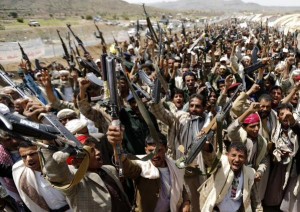Based on cache of secret slides leaked by national security whistleblower, stunning exposé by The Intercept reveals inner workings—and failures—of the U.S. military’s clandestine efforts in Afghanistan, Yemen, and Somalia
Written by Nadia Prupis, staff writer for Common Dreams. Published 10-15-15.

The Intercept has obtained a cache of secret slides that provides a window into the inner workings of the U.S. military’s kill/capture operations at a key time in the evolution of the drone wars — between 2011 and 2013. (Image: The Intercept)
A stunning new exposé by The Intercept, which includes the publication of classified documents leaked by an intelligence source, provides an unprecedented look at the U.S. military’s secretive global assassination program.
The series of articles, titled The Drone Papers, follows months of investigation and uses rare primary source documents and slides to reveal to the public, for the first time, the flaws and consequences of the U.S. military’s 14-year aerial campaign being conducted in Yemen, Somalia, and Afghanistan—one that has consistently used faulty information, killed an untold number of civilians, and stymied intelligence-gathering through its “kill/capture” program that too often relies on killing rather than capturing.
“The series is intended to serve as a long-overdue public examination of the methods and outcomes of America’s assassination program,” writes the investigation’s lead reporter, Jeremy Scahill. “This campaign, carried out by two presidents through four presidential terms, has been shrouded in excessive secrecy. The public has a right to see these documents not only to engage in an informed debate about the future of U.S. wars, both overt and covert, but also to understand the circumstances under which the U.S. government arrogates to itself the right to sentence individuals to death without the established checks and balances of arrest, trial, and appeal.”
The source of the documents, who asked to remain anonymous due to the U.S. government’s aggressive prosecution of whistleblowers, said the public has a right to know about a program that is so “fundamentally” and “morally” flawed.
“It’s stunning the number of instances when I’ve come across intelligence that was faulty, when sources of information used to finish targets were misattributed to people,” he told The Intercept. “And it isn’t until several months or years later that you realize that the entire time you thought you were going after this target, it was his mother’s phone the whole time. Anyone caught in the vicinity is guilty by association – it’s a phenomenal gamble.”
As outlined by The Intercept, the key revelations of the reporting are:
- Assassinations have depended on unreliable intelligence. More than half the intelligence used to track potential kills in Yemen and Somalia was based on electronic communications data from phones, computers, and targeted intercepts (know as signals intelligence) which, the government admits, it has “poor” and “limited” capability to collect. By the military’s own admission, it was lacking in reliable information from human sources.
- The documents contradict Administration claims that its operations against high-value terrorists are limited and precise. Contrary to claims that these campaigns narrowly target specific individuals, the documents show that air strikes under the Obama administration have killed significant numbers of unnamed bystanders. Documents detailing a 14-month kill/capture campaign in Afghanistan, for example, show that while the U.S. military killed 35 of its direct targets with air strikes, 219 other individuals also died in the attacks.
- In Afghanistan, the military has designated unknown men it kills as “Enemies Killed in Action.” According to The Intercept’s source, the military has a practice of labeling individuals killed in air strikes this way unless evidence emerges to prove otherwise.
- Assassinations hurt intelligence gathering. The Pentagon study finds that killing suspected terrorists, even if they are legitimate targets, “significantly reduce[s]” the information available and further hampers intelligence gathering.
- New details about the ‘kill chain’ reveal a bureaucratic structure headed by President Obama, by which U.S. government officials select and authorize targets for assassination outside traditional legal and justice systems, and with little transparency. The system included creating a portrait of a potential target in a condensed format known as a ‘Baseball Card,’ which was passed to the White House for approval, while individual drone strikes were often authorized by other officials.
- Inconsistencies with publicly available White House statements about targeted killings. Administration policy standards issued in 2013 state that lethal force will be launched only against targets that pose a “continuing, imminent threat to U.S. persons,” however documents from the same time reveal much more vague criteria, including that a person only need present “a threat to U.S. interest or personnel.”
- New details of high-profile drone kills, including the 2012 killing in Somalia of Bilal al-Berjawi, which raise questions about whether the British government revoked his citizenship to facilitate the strike.
- Information about a largely covert effort to extend the U.S. military’s footprint across the African continent, including through a network of mostly small and low-profile airfields in Djibouti and other African countries.
The investigation comes as the Obama administration announced plans on Thursday to delay withdrawal of U.S. troops from Afghanistan. Administration officials told CNN that troops may conduct “counterterrorism operations” against Islamic State (ISIS) militants there.
But as the documents reveal, assurances from the Obama administration that drone strikes are precise and used only in cases of “imminent” threats are themselves based on intentionally vague definitions of “imminence.”
“Privately, the architects of the U.S. drone program have acknowledged its shortcomings,” said Betsy Reed, editor-in-chief of The Intercept. “But they have made sure that this campaign, launched by Bush and vastly expanded under Obama, has been shrouded in secrecy. The public has a right to know how the US government has decided who to kill.”
As the source himself said, “We’re allowing this to happen. And by ‘we,’ I mean every American citizen who has access to this information now, but continues to do nothing about it.”
This work is licensed under a Creative Commons Attribution-Share Alike 3.0 License.
RELATED ARTICLES:







![Photo By User:Hohum [Public domain], via Wikimedia Commons](http://occupyworldwrites.org/wp-content/uploads/2014/07/WWImontage-289x300.jpg)